Are you a Quiet Speculation member?
If not, now is a perfect time to join up! Our powerful tools, breaking-news analysis, and exclusive Discord channel will make sure you stay up to date and ahead of the curve.
Nothing screams "Modern" like a bunch of crazy combos. And that's exactly what February's second half had in store for us. Turns out there are some decks that don't run Arcum's Astrolabe, after all: the ones that kill out of nowhere!
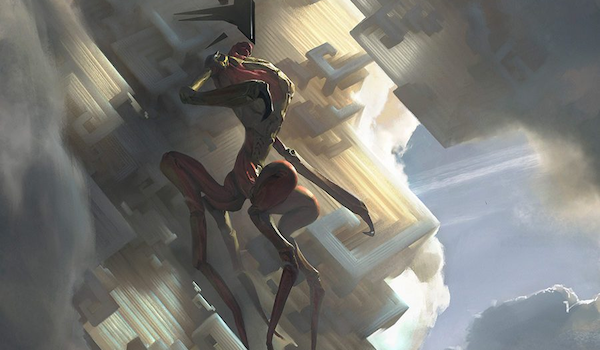
"I Was Inverted"
A the "Top" of our list is an inside-out version of Ad Nauseam.
Inverter Oracle, MINT_ (5-0)
Already a breakout deck in Pioneer, Modern's take on Inverter Oracle plays many of the same cards as Ad Nauseam: Serum Visions and Spoils of the Vault to find its combo; Angel's Grace and Phyrexian Unlife to keep from outright losing to its own devices; Pact of Negation to force through a win.
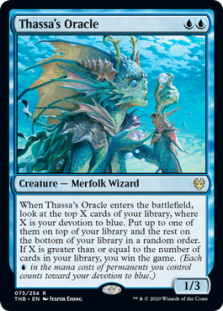 And how does it win? By emptying its library with Inverter to trigger Thassa's Oracle! Jace, Wielder of Mysteries also wins with an empty library. But both sources require players to get rid of their "new" library, the graveyard repurposed by Inverter; something like Spoils of the Vault, which can name "Faithless Looting" to empty what's left without necessarily dealing pilots 40 damage.
And how does it win? By emptying its library with Inverter to trigger Thassa's Oracle! Jace, Wielder of Mysteries also wins with an empty library. But both sources require players to get rid of their "new" library, the graveyard repurposed by Inverter; something like Spoils of the Vault, which can name "Faithless Looting" to empty what's left without necessarily dealing pilots 40 damage.
At a glance, the combo struck me as much more difficult to pull off than Ad Nauseam's. But it does have a bit more to it. With Unlife or Grace online, Inverter is no longer necessary; Spoils can empty the library by itself. And Shelldock Isle casts an Oracle straight from the library (or, The Artist Previously Known as the Graveyard) post-Inversion. Besides, Jace, Grace, and Unlife are okay disruptive cards on their own merits. Finally, while I doubt it happens very often, Inverter's 6/6 body can put the game away by itself in a pinch.
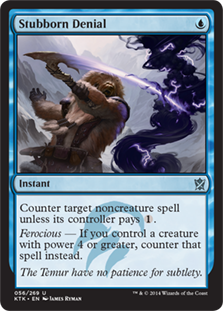 Best of all, Inverter Oracle is exceedingly difficult to disrupt. Its components are creatures, which can't be stopped by Force of Negation or Stubborn Denial; they have enters-the-battlefield effects, which care little about efficient removal. Graveyard hate in fact bolsters the deck's strategy, and Extraction effects are no match for the deck's multiple interchangeable combo pieces or Talisman's ability to yank one out of exile. So the deck needs to just stay alive long enough to actually cast its cards, which I imagine is around five turns; in other words, many slower decks may struggle to actually beat it.
Best of all, Inverter Oracle is exceedingly difficult to disrupt. Its components are creatures, which can't be stopped by Force of Negation or Stubborn Denial; they have enters-the-battlefield effects, which care little about efficient removal. Graveyard hate in fact bolsters the deck's strategy, and Extraction effects are no match for the deck's multiple interchangeable combo pieces or Talisman's ability to yank one out of exile. So the deck needs to just stay alive long enough to actually cast its cards, which I imagine is around five turns; in other words, many slower decks may struggle to actually beat it.
Jolly Green Giants
Into the forest we go, where Once Upon a Time is as enabling of degeneracy as ever.
Turbo Heliod, B1GDAN (5-0)
David covered Company decks merely splashing the Heliod-Feeder combo, but Turbo Heliod takes the strategy to its logical extreme. Being able to Collected Company into both combo pieces and instantly gain infinite life at instant speed is big game against a lot of Modern decks (incidentally, not Inverter Oracle). This deck is set up to achieve that goal as fast as possible, after which it should have plenty of time to find Walking Ballista and win from there. Teferi, Time Raveler prevents opponets from interacting on the turns that count. So far, the 4 Heliod / 4 Feeder core has surfaced in additional Company decks.
Green Devotion, RPANGRIFF (5-0)
Green Devotion is not a new Modern deck, its history dating back to the format's creation. But RPANGRIFF's latest build, which now has multiple 5-0 trophies to its name, features plenty of brand-new tech. Here's Karn, a big mana 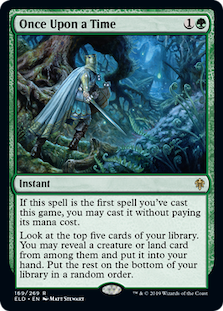 favorite; Gilded Goose, the freshest mana dork on the block; and Once Upon a Time, cornerstone of any... uh... Modern deck.
favorite; Gilded Goose, the freshest mana dork on the block; and Once Upon a Time, cornerstone of any... uh... Modern deck.
What strikes me most about this build compared to the deck's earlier iterations is how streamlined it is. There's no fussing around with random fatties, Craterhoof Behemoth, Genesis Wave, or—God forbid—Wistful Selkie. Genesis Hydra compliments Karn as a sleek mana sink, while Eternal Witness and the efficient Burning-Tree Emissary hold down the fort as devotion hubs. Between the main and the sideboard, Devotion also packs plenty of three-mana hosers to shut out opponents who fail to answer the mana dork.
Pollywannacracka
The breakout combo card of the month, though, was Jalira, Master Polymorphist—another age-old Modern reject. Like Green Devotion, this strategy has also received some major boosts lately.
Farseek Polymorph, ORIM67 (8th, Modern Challenge #12081604)
 First up is Farseek Polymorph, the apparent originator of the new build, which went on to enjoy multiple 5-0 finishes in February alone. Farseek ramps players into four mana by turn three, which is enough for the deck's namesake card to cheat in an Emrakul. In the meantime, Aura of Silence and Lightning Bolt can keep proactive opponents off their critical early plays, and should pilots fail to open the Farseek, Teferi, Time Raveler can come down on-curve for extra disruption and combo protection all in one (Jalira, Master Polymorphist is notoriously easy to kneecap; just shoot the targeted creature and the whole spell fizzles). Aura of Silence can also be used on the combo turn as a one-shot Teferi effect. Goremand occupies the same spot on the curve as Farseek, pushing the game back a turn while digging for combo pieces.
First up is Farseek Polymorph, the apparent originator of the new build, which went on to enjoy multiple 5-0 finishes in February alone. Farseek ramps players into four mana by turn three, which is enough for the deck's namesake card to cheat in an Emrakul. In the meantime, Aura of Silence and Lightning Bolt can keep proactive opponents off their critical early plays, and should pilots fail to open the Farseek, Teferi, Time Raveler can come down on-curve for extra disruption and combo protection all in one (Jalira, Master Polymorphist is notoriously easy to kneecap; just shoot the targeted creature and the whole spell fizzles). Aura of Silence can also be used on the combo turn as a one-shot Teferi effect. Goremand occupies the same spot on the curve as Farseek, pushing the game back a turn while digging for combo pieces.
As far as those go, Jalira, Master Polymorphist finds itself joined by relative newcomer Indomitable Creativity. The sorcery costs a whopping triple red, but does come with some  benefits, most notably the ability to pop opposing artifacts that hold back the combo (such as Grafdigger's Cage, a card David identified as exceptional against the format's top decks).
benefits, most notably the ability to pop opposing artifacts that hold back the combo (such as Grafdigger's Cage, a card David identified as exceptional against the format's top decks).
While older Jalira, Master Polymorphist decks had to run token generators or manlands, the former of which cost mana and a card and the latter of which ran the risk of extreme blowouts, Farseek Polymorph makes great use of a new land, Dwarven Mine. Mine can be fetched, as could Arbor, but it can't be shot by Lightning Bolt before players get a chance to untap with it. Even Farseek can grab it, making having a creature in play for the sorceries even more reliable.
Control Polymorph, CHERRYXMAN (3-2, Modern Preliminary #12086251)
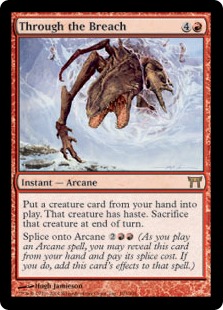 CHERRYXMAN whipped up this control build of Polymorph in a league posted after the ORIM67 list's, then continued to post results with it throughout the month. It's less all-in than the Farseek build, as there's no ramping. CHERRYXMAN therefore expects to survive a full turn longer than ORIM67 does in many games. To compensate, the control build drops Aura of Silence and ramps up on board interaction, including the flexible Abrade and all-purpose Path to Exile.
CHERRYXMAN whipped up this control build of Polymorph in a league posted after the ORIM67 list's, then continued to post results with it throughout the month. It's less all-in than the Farseek build, as there's no ramping. CHERRYXMAN therefore expects to survive a full turn longer than ORIM67 does in many games. To compensate, the control build drops Aura of Silence and ramps up on board interaction, including the flexible Abrade and all-purpose Path to Exile.
A plan both builds share is Through the Breach from the sideboard, which gets around Grafdigger's Cage and the like and effectively attacks opponents from a new angle while using the same huge monster. Additional Emrakuls come in to increase the reliability of this plan. Rest in Peace and Leyline of Sanctity, both low-investment, high-reward hosers, are also maxed out by both decks.
1+1=20
As ever, combo is alive and well in Modern. And the format seems to be positively bursting with possibilities! Join me next week for an exposé what I consider to be a midrange renaissance. Until then, may you open the right pair of cards... or just Once Upon a Time!




So one slight nitpick with the polymorph deck…since Dwarven Mine says you create a token “if” it entered untapped, you can’t farseek for it and get a token. It still does a great job of getting you to combo a turn earlier though.
Ooh, nice catch! That’s too bad, but yeah, like you said Seek does help set up the Mountain requirement.